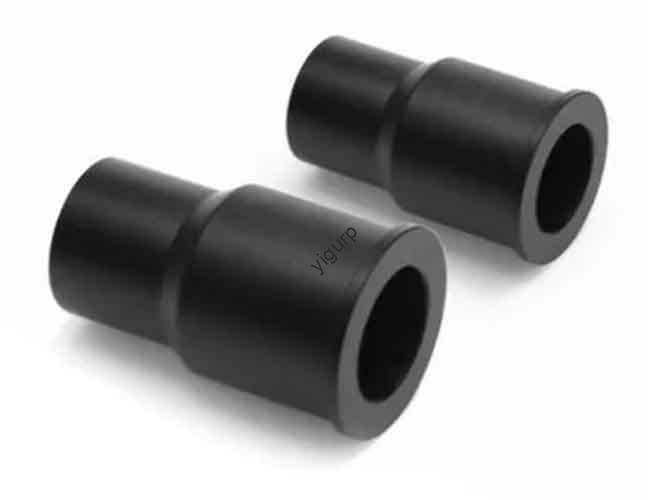Quando si sviluppa un depuratore d'acqua, la fase di prototipo determina direttamente se il prodotto finale soddisfa le esigenze degli utenti e gli standard del settore. Tra tutti i metodi di produzione di prototipi, MACCHING CNC si distingue per la sua precisione e affidabilità, ma perché è indispensabile per i prototipi di depuratori d'acqua? Questo articolo analizza gli aspetti chiave dei prototipi di depuratori d'acqua lavorati a CNC, from design to testing, to help you understand its value.
1. Core Design Principles for CNC-Machined Water Purifier Prototypes
A successful prototype starts with design optimization tailored to CNC capabilities. Below are three non-negotiable design focuses:
| Design Aspect | Requisiti chiave | CNC Compatibility Note |
| Functional Design | – Smooth internal water flow channels (no dead ends).- Tight filter element interfaces (for PP cotton, RO membranes, ecc.). | CNC’s high precision ensures channel dimensions match filter sizes exactly. |
| Structural Strength | – Uniform shell thickness (to resist 0.3–0.6MPa water pressure).- Reasonable support structures (PER ESEMPIO., stiffeners). | CNC simulates real-use pressure via consistent material removal. |
| Maintainability | – Modular parts (removable panels, easy filter access). | CNC enables precise cutting of assembly clearances (avoids loose/tight fits). |
2. What Advantages Does CNC Machining Offer for Water Purifier Prototypes?
Compared to 3D printing or manual machining, CNC machining provides unique benefits that directly improve prototype quality. Ecco un confronto fianco a fianco:
| Categoria di vantaggio | CNC Machining Performance | 3D Printing Limitation |
| Precisione | Dimensional precision up to ± 0,05 mm (ideal for fine holes like water inlets). | Typical precision of ±0.1–0.3mm (risk of leaky joints). |
| Versatilità materiale | Processes plastics (Addominali, acrilico), lega di alluminio, e rame. | Limited to plastic filaments (poor for metal waterway tests). |
| Finitura superficiale | Supports post-treatment (spruzzatura, placcatura) for mass-production simulation. | Superficie ruvida (requires extra sanding; hard to replicate factory textures). |
3. Step-by-Step CNC Machining Process for Water Purifier Prototypes
CNC machining follows a linear, repeatable workflow to ensure consistency. The process is divided into 5 Fase chiave:
- Model Splitting & Programmazione
Split the 3D model into machinable parts (PER ESEMPIO., conchiglia, liner, filter holder). Select tools (high-precision ball nose cutters for curves) and optimize parameters (rotational speed, velocità di alimentazione) to reduce material deformation.
- Ruvido
Quickly remove 90% di materiale in eccesso, lasciando un 0.5–1mm allowance per finire. This step saves time while protecting the final shape.
- Finitura
Use low-feed, high-speed cutting to achieve a surface roughness of Ra0.8–Ra3.2—critical for smooth water flow and user comfort (no sharp edges).
- Special Structure Treatment
- Threaded/mounting holes: Machined via spiral milling to prevent slippage.
- Complex curved surfaces: Achieved via 5-axis CNC for seamless waterway connections.
- Legame & Assemblaggio
Use epoxy or instant adhesive to simulate mass-production methods (PER ESEMPIO., scatta, viti), testing real-world assembly logic.
4. Material Selection Guide for CNC-Machined Prototypes
Choosing the right material directly impacts prototype performance. Below is a practical material-scenario match:
| Tipo di materiale | Applicable Prototype Parts | Caratteristiche chiave |
| Plastica addominali | Shell, pannello di controllo | Easy to polish/plate; basso costo; mimics mass-produced plastics. |
| Transparent Acrylic | Water tank, internal viewing window | Elevata trasparenza; allows observation of water flow. |
| Lega di alluminio | Internal brackets, waterway joints | Leggero, resistente alla corrosione; ideal for metal part testing. |
| Nylon | Filter element card slots | Self-lubricating, resistente all'usura; easy to test filter replacement. |
5. Post-trattamento & Test funzionali
A CNC prototype is only valid if it undergoes rigorous post-processing and testing to simulate real use.
Key Post-Treatments
- Macinazione/lucidatura: Removes knife marks (critical for plastic shells’ feel).
- Pulizia ad ultrasuoni: Eliminates residual cutting fluid (prevents waterway contamination).
- Simulation Treatments:
- Spruzzatura (PER ESEMPIO., matte black/white) to replicate factory textures.
- Screening della seta (Loghi, parameter labels) for user-friendliness.
- Placcatura (stainless steel luster) per parti metalliche.
Must-Perform Tests
| Tipo di test | Scopo | Passa criteri |
| Assembly Verification | Check filter installation, pipe docking, and button/display usability. | Smooth filter replacement; clear display view. |
| Water Flow Test | Verify waterway efficiency (use dye/flow meter) and leak resistance. | No leaks at 0.3–0.6MPa; uniform water flow. |
| Weathering Test | Simulate long-term use. | No plastic discoloration (UV test); no metal rust (corrosion test). |
6. Yigu Technology’s Perspective on CNC Machined Water Purifier Prototypes
Alla tecnologia Yigu, we believe CNC machining is the cornerstone of reliable water purifier development. A differenza della stampa 3D, CNC’s ±0.05mm precision solves common prototype pain points—such as leaky waterways or loose filter slots—that could derail mass production. We often recommend clients prioritize CNC for core parts (conchiglie, waterway liners) while using 3D printing for non-critical components to balance cost and quality. Per esempio, a recent project using CNC-machined aluminum liners and ABS shells reduced pressure loss by 15% and cut filter replacement time in half. Alla fine, CNC prototypes don’t just test design—they accelerate the path from concept to market.
Domande frequenti
- How much does a CNC-machined water purifier prototype cost?
The cost ranges from 500 A 3,000 yuan per unità, depending on part complexity and material. To control costs, focus on machining key components (PER ESEMPIO., conchiglie) and use 3D printing for secondary parts.
- How long does it take to make a CNC-machined water purifier prototype?
Typically 5–15 days. For faster turnaround, split complex parts into smaller components and process them in parallel.
- Can CNC machining simulate all mass-production features of a water purifier?
Yes—CNC supports post-treatments like spraying, placcatura, and silk screening to replicate factory finishes. It also tests assembly logic (PER ESEMPIO., scatta, viti) that match mass-production methods.
